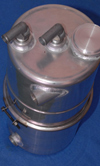Oil Pump Cavitation
 Apart from the accidental ingress of debris, the greatest danger to any design of oil pump, particularly one of the gear tooth design, is that of cavitation. Commonly found in centrifugal pumps also, the presence of this phenomenon and the resulting surface erosion is often confusing to the uninformed.
Apart from the accidental ingress of debris, the greatest danger to any design of oil pump, particularly one of the gear tooth design, is that of cavitation. Commonly found in centrifugal pumps also, the presence of this phenomenon and the resulting surface erosion is often confusing to the uninformed.
A complex process having one of many causes, for an adequate explanation we need to understand and explore some of the more basic principles of fluid mechanics. In particular if we consider the case of steady flow along a streamline as the velocity increases at a point then it is an established fact that the pressure will decrease. In the case of a liquid however, this pressure cannot drop below that of the vapour pressure at the temperature of concern. If for any reason the pressure falls to the vapour pressure then the liquid will boil instantaneously and tiny bubbles will appear at that point in very large numbers. As these bubbles are carried along in the flow there will come at time when the pressure will rise again to that above the vapour pressure and the bubbles will instantly collapse again as the liquid condenses. This process of condensing will cause a void or cavity to be created and the surrounding liquid will rush in to fill the space available. Moving in from all sides the liquid will collide at the centre causing an extremely high-pressure zone, which together with the associated shock waves generated may be enough to severely damage the surface of any metal component in the vicinity. The surface doesn’t have to be exactly at the point of the implosion since another process called ‘water hammer’ can transfer this energy rapidly through the liquid. Either way the surface may be subject to considerable fatigue damage, rapidly eroding the surface of the component. Gear oil pumps, as a result of careless design or inadequate servicing, are particularly prone to this phenomenon and high-speed racing engines especially those with dry sump systems, are likely to suffer most.
Unlike most other engines, by nature of their high speed and the fact that air is often encouraged to pass through the crankcase, racing engines tend to dissolve more air into their oil. The presence of the swirl tank at the end of the oil return line will separate out and vent much of this, but nevertheless the feed to the oil pump will almost certainly contain a small but not insignificant amount of dissolved air which will be kept in solution by the pressure of the pump. If the pressure of the oil in the system drops to below that required to keep this air in solution, the air will quickly vaporise and then collapse again as soon as the pressure increases. Depending upon the pump design and local flow conditions, cavitation wear can therefore take place at any point in the system but because of the rapid changes in flow velocity, mainly within the pump rotor. Gear pumps running at very high speeds, much higher than those originally intended, are particularly susceptible to this form of wear.
Poor tank design, air leaks on the intake side to the pump as well as restrictions in the oil pick up arrangement (including inadequate hose sizing) can be other causes of this problem.
Written by John Coxon.